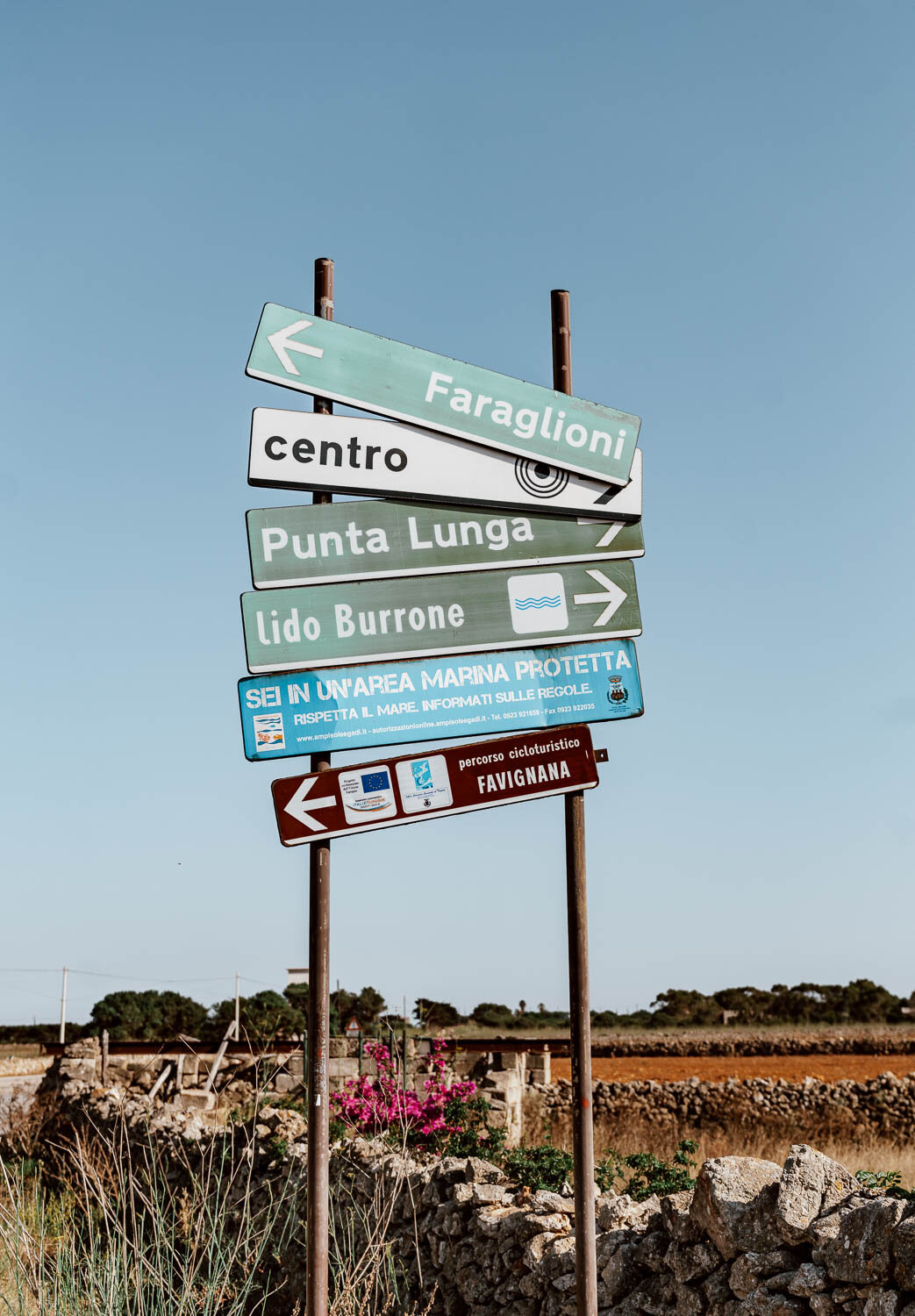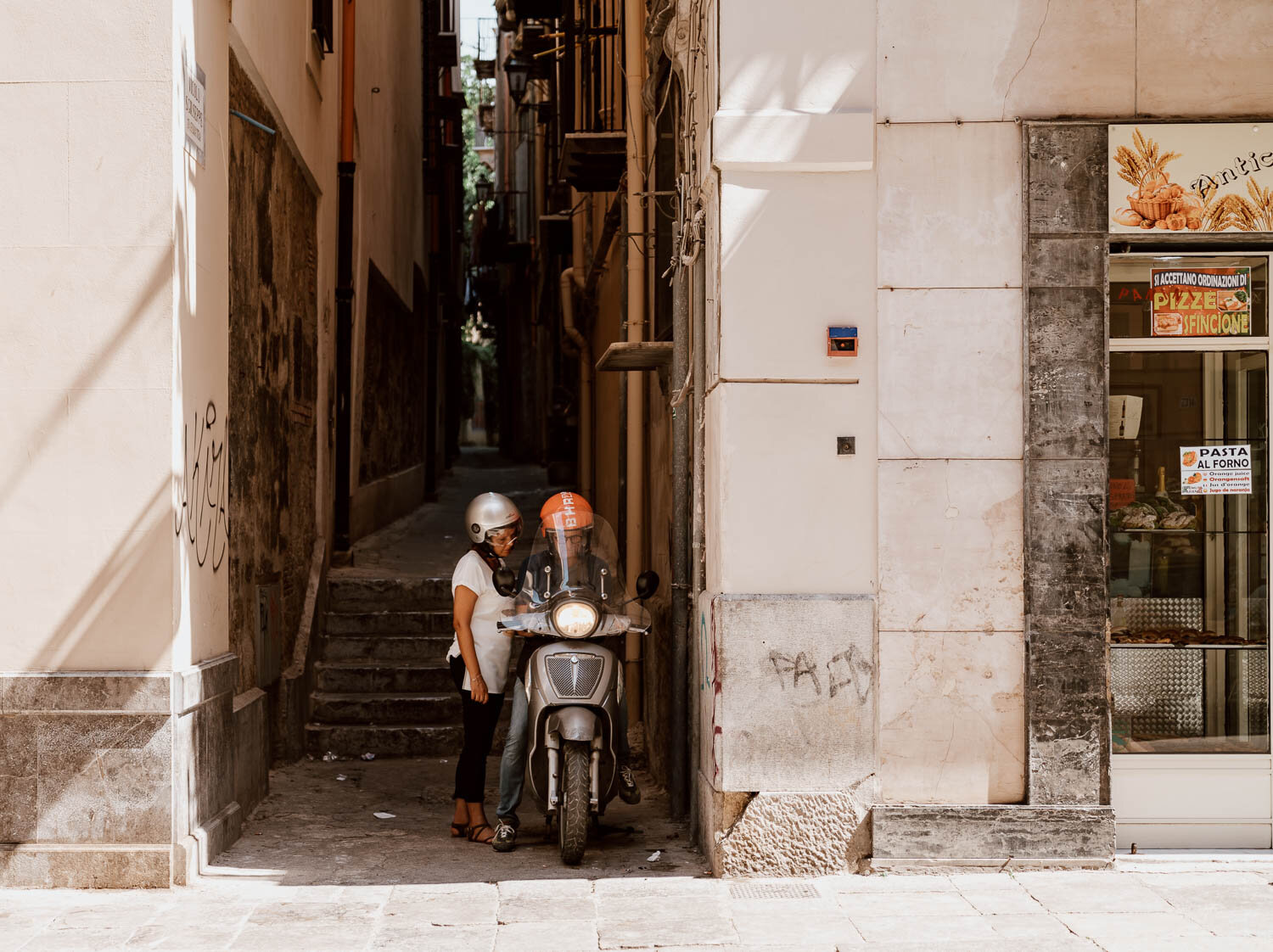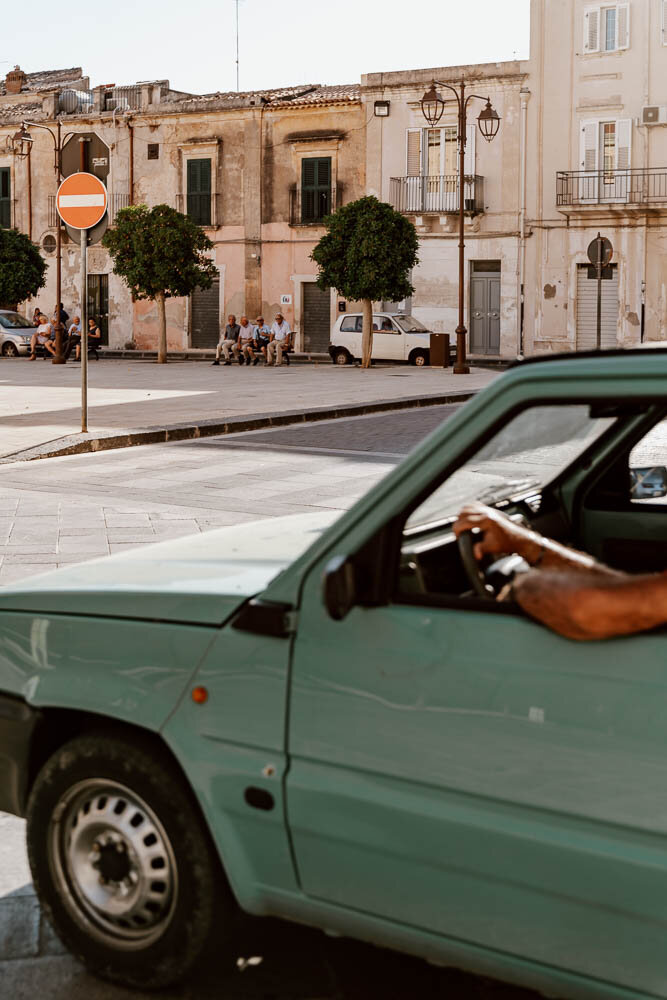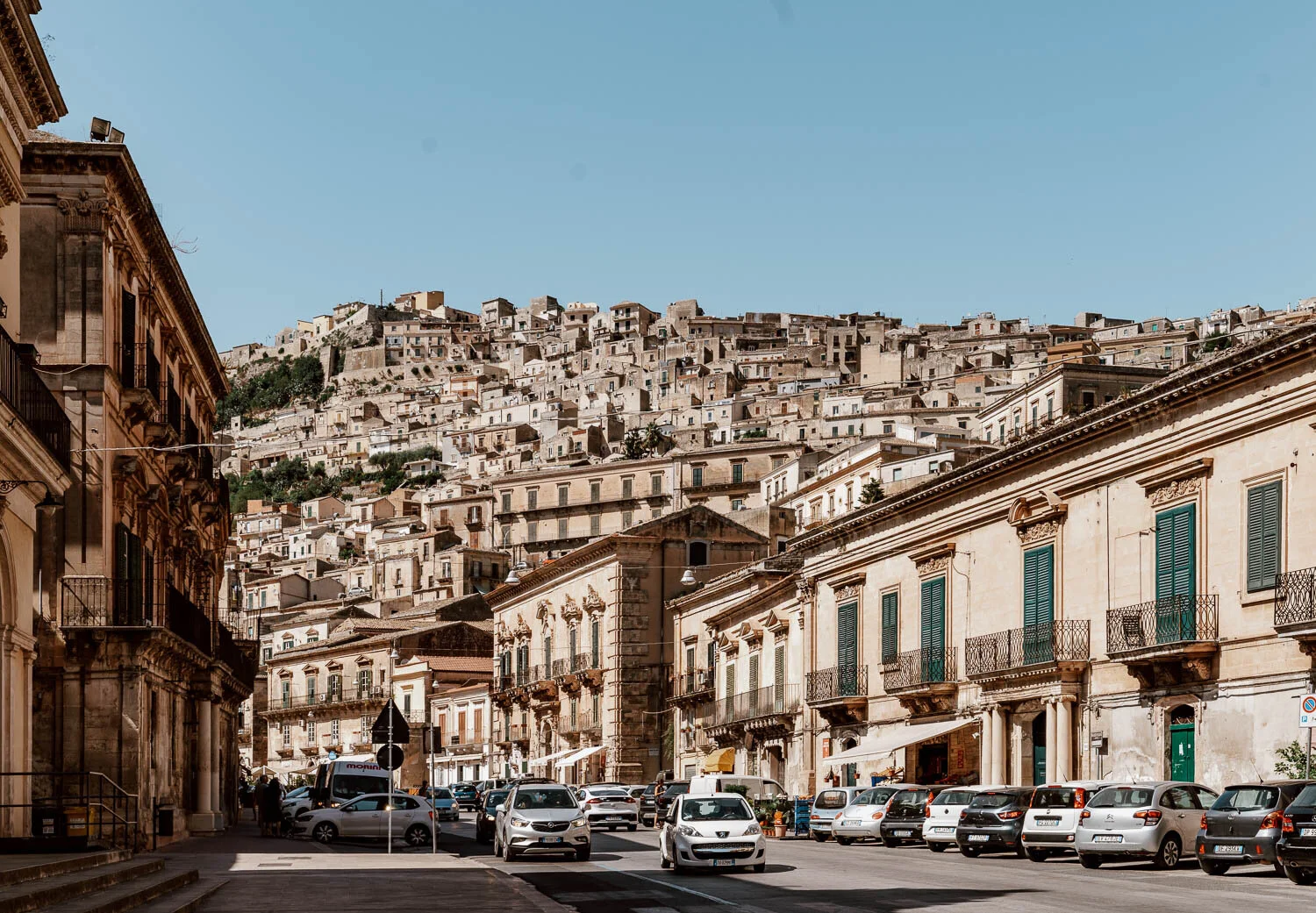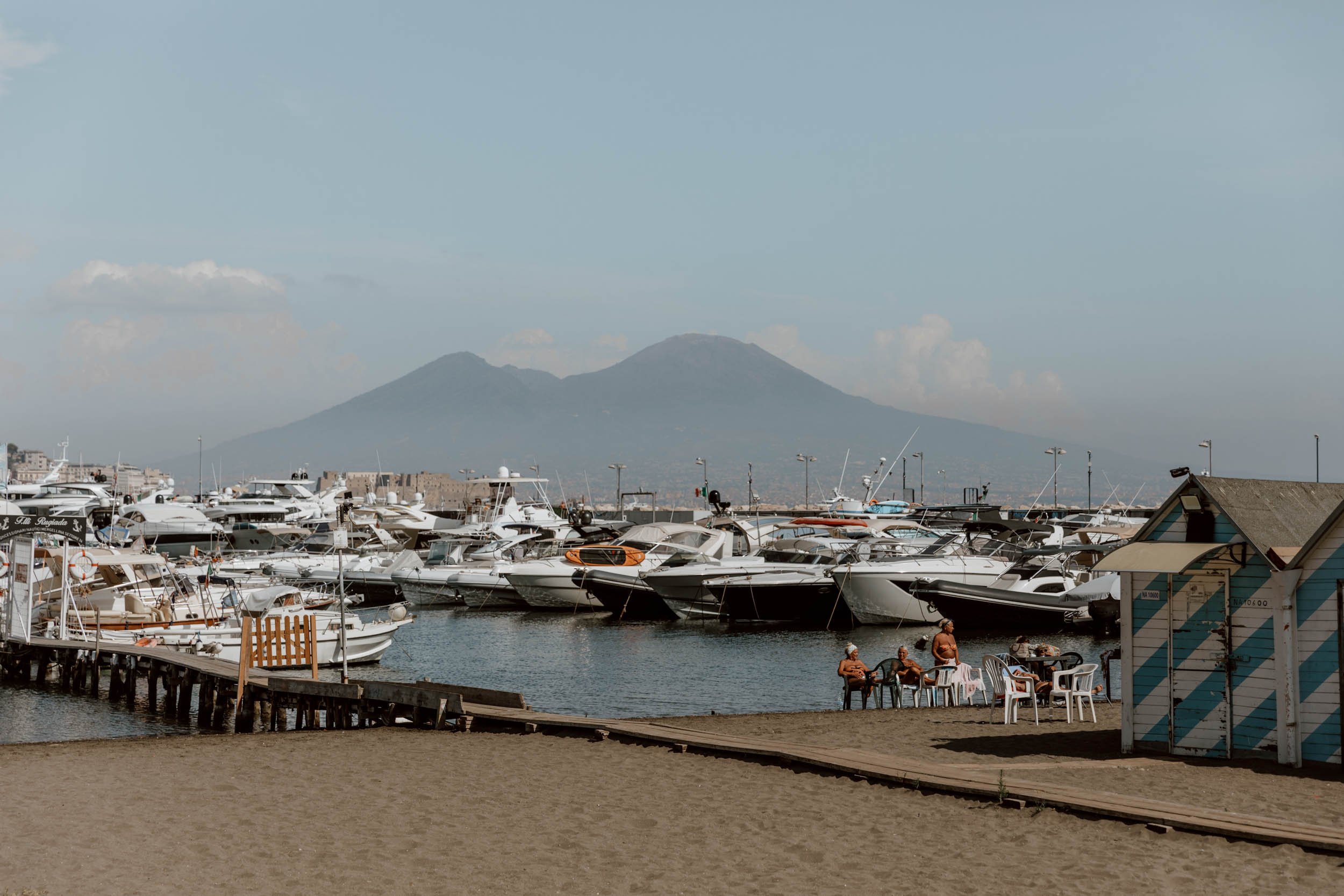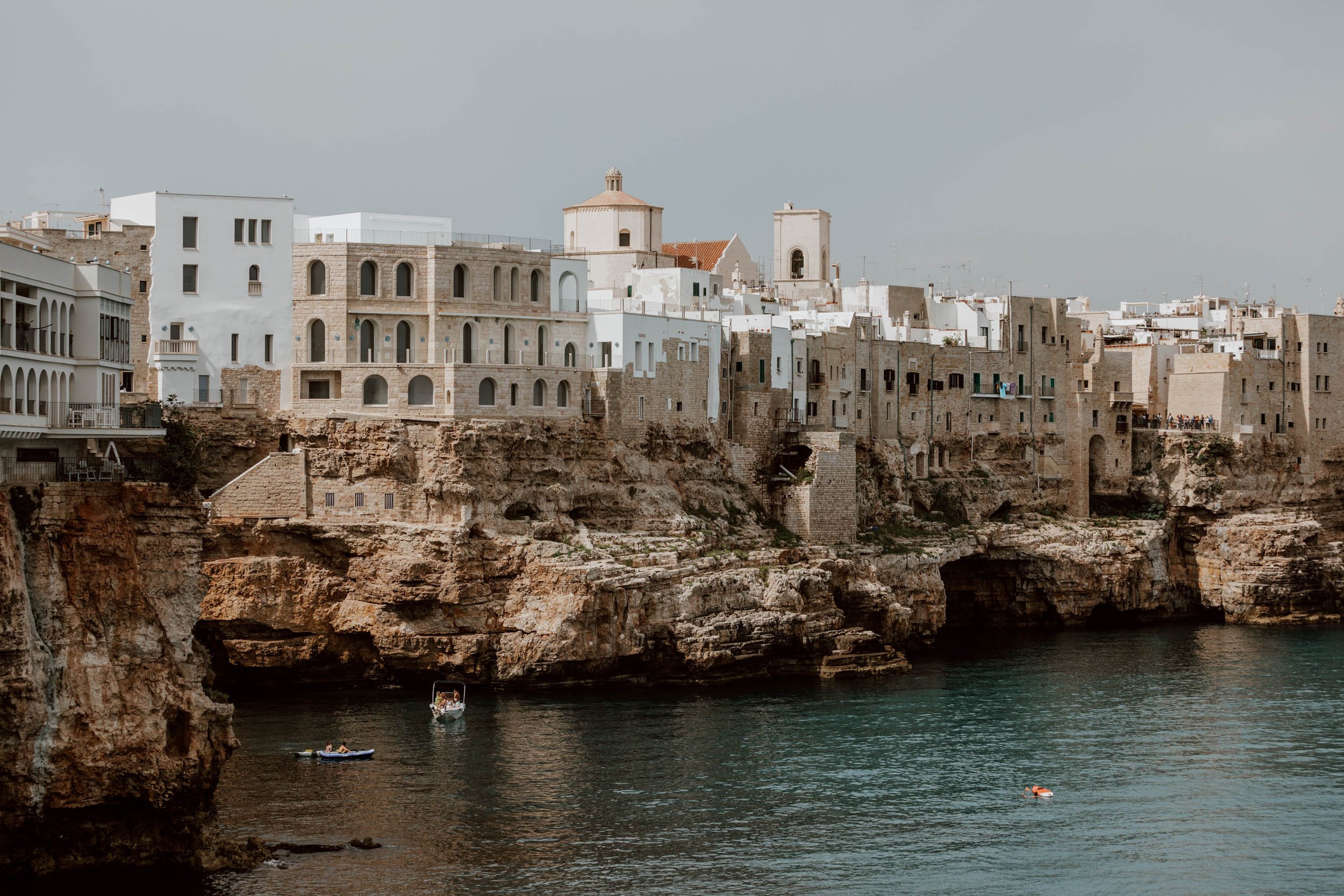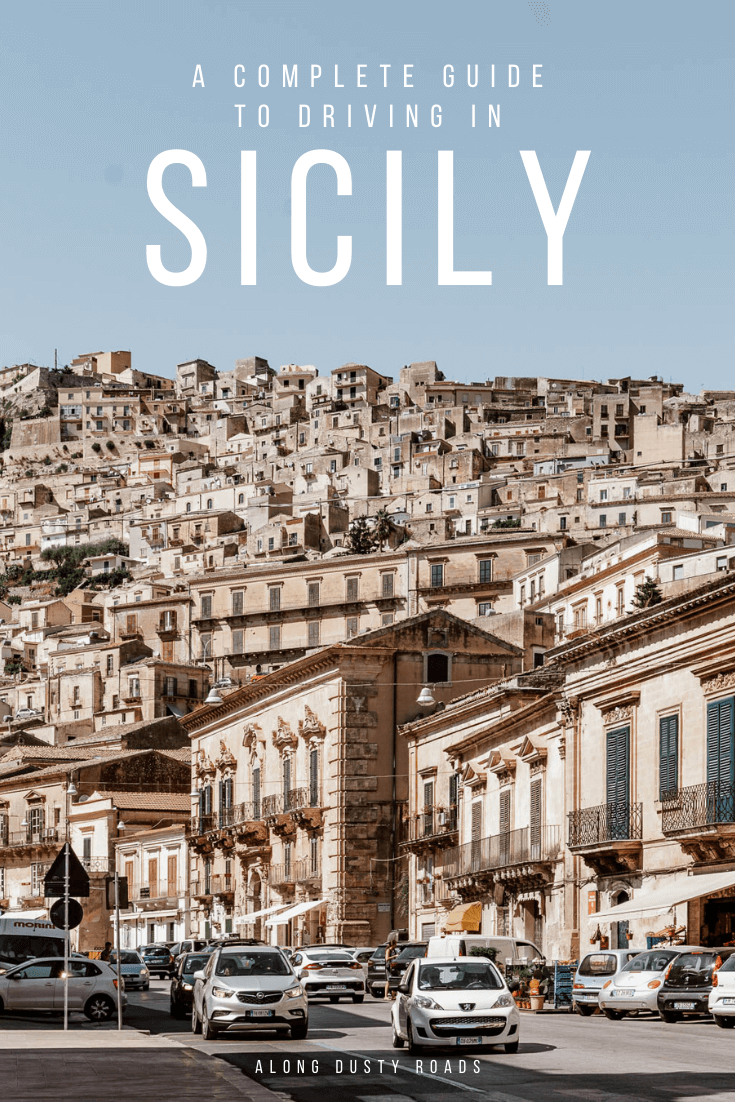In the middle of working out whether you want to rent a car in Sicily and have a road trip? Or have you already decided on it, but are now in a bit of a panic about the practical realities and challenges of driving in Sicily?
This is the post for you!
Updated April 2024
"The rules of driving in Sicily,' she said, "appear to have been a passed down in a similar way to the recipe for the best sauce for pasta alla norma - secretly, unwritten, and with each family claiming that they have the best one".
Midway through our month-long summer road trip in Sicily, after a particularly fraught gesticulatory exchange with a young guy in the car which went, in very quick succession, from closely behind, closely beside, to closely ahead of us, Emily had cracked the code.
There do appear to be driving rules in Sicily, but to the outsider and first-time roadtripper in Italy, it will seem like each person has their own version or interpretation of them. Instead of the Highway Code and a strict adherence to white lines and red stop signs, the rules of the road on this gorgeous southern Italian island instead appear to have been passed down from generation to generation, understood but not shared, and perhaps really only made to be broken or creatively challenged.
Driving in Sicily was something that we were sincerely worried about at the outset; a few followers on Instagram told us how crazy it was and an old friend of Emily’s said that it was not an enjoyable experience at all for her.
However, we knew that a road trip was the best - and only way - for us to experience Sicily in the way that we like to travel, and so we would simply have to bite the bullet. And having driven around Morocco and elsewhere in southern Italy in the previous few years, surely driving in Sicily couldn’t be THAT bad?
The good news, for those of you currently bricking it or a little daunted by the prospect, is that the reality of driving in Sicily was not nearly as chaotic, lawless or stressful as we had anticipated and feared.
That isn’t to say that there were no moments of exasperation, frustration, or incredulity at the general approach to driving and some close shaves, but it’s simply to give you the reassurance that driving in Sicily on your own adventure should not be something to fear or avoid.
Driving in Sicily is however something you need to prepare for.
So, after a fantastic month exploring with our rental car, we are well placed to give you some incredibly useful insights your own Sicily road trip! In this post, we’ve shared practical tips, things to avoid and look out for on the road, two itinerary ideas, plus a few easy ways to save money on your Sicily car rental too.
Start Cautious, Be Patient, Then Go Native
So, the overarching piece advice for you is to not be overly worried about the state of driving in Sicily.
There are of course a number of local quirks, idiosyncrasies and things to get used to and be aware of, but it's not quite as crazy as the reputation. Crazier in parts than anywhere else we’ve driven in the world though? Absolutely.
As a driver, the biggest thing to get used to is that self interest dominates the Sicilian road; cautious, sensible driving is not the norm.
This means that many sensible habits like slowly merging from slip roads, giving way on roundabouts, staying a sensible distance ahead or behind, or stopping at red lights, are just are not looked at in the same way as in other places.
Secondly, as you'll witness on your first day, most cars and hubcaps in Sicily bear the battles scars of that distinctive driving style. It was almost comical how many we saw that suffered scrapes with metal, dings from concrete or hubcap scratches from the kerbside. It’s clear that once you have a car on this island, it goes into battle and you run it to the ground.
This is why it felt like an inevitable that our car would get a ding or a dent or a dunt - thankfully it didn't!
As with any road trip in a foreign land, the first two days will be your adjustment period. Make sure you take it carefully and with a huge dollop of patience; it's important not to panic or get too stressed out by what's going on around you (having a calm navigator in the passenger seat helps a lot with this!). By the third or fourth day, you'll have worked out some of the unspoken rules of Sicily's roads - even if many make absolutely no sense.
By the end of the first week, you'll have (almost) gone native and start to enjoy the sport!
If you are a young, inexperienced, nervous or cautious driver, then the adjustment period will be a little longer and you will probably have more moments of discomfort - just breathe, take your time, go at your own pace, and focus on what you're doing.
Oh, and remember to drive on the right in Sicily!
If there’s one photo we took during our month here that best sums up the issues with Sicilian driving, we think this is it :)
Understand the Dreaded ZTL
The biggest chance of getting a fine anywhere in Italy is because of the Zona Traffico Limitato.
Found in the old centres of most Italian towns and cities, they're sensibly used to reduce congestion in high traffic areas and make them more pleasant for pedestrians and residents. In Sicily, the centres of popular places like Cefalu, Ortigia, Trapani, and Palermo are a ZTL zone (but some resident's vehicles are permitted inside these).
Unfortunately, many a tourist doesn't know about ZTLs and ends up driving right past one of the cameras used to check for breaches - the result is a fine sent through the post up to 12 months later! It's actually quite a huge revenue generator for local councils (read here), but it will cost you extra too because all Sicily car rental firms will charge you in addition for any fines or breaches they have to notify you about.
However, now you know about them, you'll know how to avoid them! The ZTL sign is a circle with a blank white centre and red outline (see picture below), sometimes it will say Zona Traffico Limitato and sometimes it won't. Some areas and zones have some exceptions about times you can enter, but the safest way is to just avoid driving into these zones entirely. Thankfully, it’s easy to do this once you know to look out for them.
Our rule of thumb is: if your route is going to take you through, via, or close to an old town or city centre, then it’s likely that there will be ZTL areas to avoid.
Indicators Do Not Indicate
The easiest way to tell whether it's a tourist in the car in front of you in Sicily is whether they're using the indicators or not.
Seriously.
In our experience, Italians rarely seem to use them and definitely view their efficacy and purpose in a different way to Brits and Germans.
You may read this and understandably assume that this can cause a few issues when navigating a busy roundabout: you would be 100% correct in that assumption. When driving in Sicily, roundabouts are a bit of a free for all. You need to approach them with caution and do not take for granted that the usual ‘give way’ system is in operation (or that anyone will indicate!). Due to this, you really do have to be a little more (cautiously) aggressive in your driving than usual, otherwise you’ll be stranded at the front of a line of increasingly irate Italians.
Similarly, you have to assume that any vehicle joining the road from the right is just as likely to pull out in front of you as it is to wait patiently. Also, on the motorway someone won’t necessarily let you know that they’re about switch lanes and cut in right in front of you either, which is equal parts stupid and dangerous.
In short, right of way is frequently determined by your balls to claim right of way or willingness to simply ignore oncoming traffic (we actually just found it hilarious when a nonna in a battered Fiat Panda would cut us off).
The Overtaking Clusterf*ck Technique
For us, the biggest source of frustration, outrage, concern, a few horn peeps, and incredulity, was how Sicilian drivers overtake.
Genuinely, the worst in the world.
Cars will sneak up very close and zoom past you before you know it, all whilst coming VERY close to your driver side (and sometimes the passenger side). Tailgating, as the Americans would call it, is very very common - even if you’re going at the speed limit.
The Sicilian overtaking technique appears to be the following: the car that's being passed (i.e. you) have to pull in towards the side of the road to ease the passage of the zealous overtaker. Obviously, that means a lot more mirror checking than usual, and it also means that the overtaking vehicle often won't go all the way over to the other side of the white line when passing, hence the panic that can come if they overtake you and you're in, you know, the place that you should be on the bloody road!
When you flip the roles, the car ahead of you will sometimes indicate to tell you to pass them - as ever, this is advice not an order, so don't feel you have to overtake if not safe. Motorbikes and scooters do have a tendency to undertake, so please please please just keep an eye on the mirrors more than you would at home when driving and especially when overtaking.
In defence, we should note that drivers on the island are not as heavy on the horn as we'd expected. Indeed, it was often Andrew resorting to it in exasperation or as a warning / admonishment to someone taking us by surprise.
And due to that use of the horn, they would probably have instantly known that we were not Sicilian (with or without looking at the indicators).
The Light At The End (And Beginning) Of The Tunnels
Although nowhere near as numerous, terrifying or claustrophopbic as the tunnels we had to drive through in the Faroe Islands, you do have to know how to approach the multiple traffic tunnels you'll drive through in Sicily.
In our experience, these tunnels were always on main roads, well-lit, and treated sensibly by most drivers; there was one that we drove through however where a car had broken down in the middle of it (but thankfully they had put their hazards on).
Always have your lights on before you enter the tunnel (not on full beam though) and adjust your speed accordingly. There are always signs at the entrance reminding you of both steps.
Sunglasses are essential for driving in Sicily, but note that these can affect your vision in the tunnels - only take them off if safe to do so.
Though comfortably wide enough for two cars coming from opposite directions, there wasn't too much give on the side of some of the tunnels and we can't recall any hard shoulder spaces, so stick to your lane rather than hugging the middle.
How To Save Money On Your Sicily Rental Car
There are three essential things to know when it comes to saving money on a road trip, and they're all things you need to do before booking your rental car in Sicily.
Pick the Right Car
As Andrew always tells Emily, smaller really is better....especially when it comes to rental cars in Sicily.
In the old town streets or narrow countryside lanes or winding mountain roads for Taormina, Erice, and Lo Zingaro Natural Reserve, a massive SUV or a wide BMW is only going to make your job more difficult.
Of course, if you're a family or a large group, you need to get the right vehicle to fit you and your luggage comfortably. However, if you can go with something smaller then it will make parking and driving much easier overall, plus cost you far less on the rental.
We rented a Fiat 500 in Sicily, and it took two medium-sized suitcases and all our other stuff with no issues. Note that it isn't uncommon to request a manual and receive an automatic in Italy, and vice-versa.
Where You Book Online
Booking further in advance provides you with a greater selection of cars and deals for your dates; if you leave it last minute in summer season, then there's a high chance you'll only be left with expensive, fancy models wholly unsuited to your budget or travel style, or with some of the scummy car rental companies.
We often book our rental cars for road trips via the Auto Europe website. It provides you options for both the local and international rental car companies in Sicily, so you can easily compare options, reserve and pay online for the car in one place. That website always gives us much cheaper deals than RentalCars.com and is usually cheaper than booking direct with the rental firms too.
For 20 days of rental, our car cost £202 - which is a really excellent rate per day. Check rates and availability for your travel dates here.
On a few recent trips, we’ve also booked via Rentalcars as the number of suppliers has increased and prices reduced.
The trick is to search on both and find the best deal for your dates!
Palermo, Catania, and Trapani Airports all have multiple car rental companies, and you are always cheapest to collect your rental car from the airport rental offices. It’s also the most convenient option. However, do note that there’s frequently a waiting time to collect at Palermo and Catania Airport as so many people are arriving and renting from the same incoming flight. Also, dropping it off at a different airport on departure will increase the rental costs.
Some companies also have offices in the cities and other popular tourist towns in Sicily (like Syracuse and Noto) in case you just want to do a day-trip or rent for a few days.
Rental Insurance Mistakes
We have taken so many road trips in the last few years, and the biggest money-saving tip revolves around the rental insurance.
Every car rental firm will include a standard insurance for renters, but with a massive excess / deductible (typically £1000 or more) which you have to cover in the event of a large claim; you will have to cover any claim falling under that amount. So, if you have £400 or £950 worth of damage, you have to pay for it.
The company will always offer you extra insurance, at an extra cost per day, to reduce this deductible and your exposure down to £0 (zero). However, it is far more expensive than it should be - but so many first-time roadtrippers understandably end up paying for it for peace of mind.
You don't have to make that mistake.
We always get the extra insurance - which is essential for Sicily given the damage on nearly every vehicle - but we never ever buy it from the rental company.
Instead, for the last two years, we have bought a 12-month worldwide Car Hire Excess Insurance policy for £59.99 from insurance4carhire. This applies to all our car rentals in the year, and will fully reimburse us for the excess or repair costs in the event of a valid claim for damage or theft. It also fills in the coverage gaps for windows, headlights, roof, tyres and undercarriage etc.
Getting the extra insurance this way saves us a lot of money whilst ensuring the additional protection. It also instantly removes a lot of our stress about car rental costs unexpectedly racking up if we have a crash or minor scrape. Even if you’re just doing one holiday road trip per year, buying that policy still works out cheaper than what’s offered at the rental desk or when booking online. For our Sicily road trip, it saved us over £240 (more than the actual car rental cost!)
The company also offers an annual policy for just UK & Europe car rentals for £44.99 (see more information here), which is definitely the best value option if you know you won’t be road tripping outside Europe in the upcoming year. Unfortunately, it’s only available to UK & EU citizens, and we haven’t been able to source an equivalent for Americans; if you know one, please share in the comments.
If it's your first road trip or driving holiday abroad with a rental car, then we highly recommend reading this post - 9 Essential Car Rental Tips for Travellers - where we discuss the insurance issues in more detail, plus other essential things to know before you rent or pick up your car in Italy or anywhere else (including how to properly document pre-existing damage on the vehicle).
Check car availability + prices for your dates here.
A Good Navigator Is As Important As The Driver
This is vital to the success of any road trip.
Cruising along the Sicilian autostrada is fun and won’t pose too many issues for the driver, but getting out of the airport for the first time, knowing when to merge then turn left then turn right down narrow city streets to find your Airbnb, and handling the scrum of traffic outside Palermo at rush hour will.
The role of the navigator in advance of these types of situations arising is to seize control of the GPS, look for turns or signs ahead of time, and give out calm, patient instructions, and help make things as clear as possible for the driver.
It hugely reduces the stress for everyone and makes things a lot easier for the driver (and your future relationship) - trust us!
Plan | Our Eastern Sicily Itinerary
The Petrol Station Puzzle
Firstly, prices for fuel across the island and between gas station companies varied wildly; keep an eye out on prices as you're driving around to get a proper guage of what's reasonable before having to fork out for a full tank and to work out which companies offer the best rates.
In Sicily, you will usually have the option to pay someone to fill your car up at the petrol station or to do it yourself. The former is always more expensive per litre than the latter (two prices are shown on signs), but obviously is much more convenient and allows you to fill up and pay without getting out of the car. Simply indicate to the person how much you want (i.e. 20 euro) or say ‘Il pieno, per favore’ (fill her up please!). It was always possible to pay by card too, and the attendant would bring the machine to us in the car.
As cheapskates, we often went for the 'do it yourself' option but noted that it frequently had obstacles set up across the stations i.e. broken payment machines, no cards accepted, taped down nozzles, the ability to only put in a single note and fill up for that amount at once (rather than pay in multiple notes).
Whether these nudge factors to make you pay more per litre are actually intentional or not, we couldn't possibly comment...many Sicilians seem to just fill up with small amounts anyway, but it did mean that we could never fill up properly on our own at several stations we stopped at or pay by card.
That won't always be the case for you but it's definitely to bear in mind; you should therefore always have some notes with you when on the road and not solely rely on card payments for fuel!
A few handy phrases to know in advance: Benzina = Petrol / Senza Piombo = Unleaded petrol / Diesel = Diesel!
Speed Limits & Toll Roads
Speed Limits In Sicily
Whilst it may appear that everyone around you is flouting the rules, you should always adhere to the speed limits in Sicily. There are an abundance of cameras an hidden radars around the island, and we’d hate for you to get caught.
Speed limits are 130 kmph on highways, 90 or 110 kmph on secondary roads, and 50 kmph (or slower) in urban areas. If you do break the speed limit and are fined, then this will also incur an extra adminstation charge from the car rental company..
Toll Roads
There four autostrade (motorways) in Sicily: Catania-Palermo, Messina-Rosolini, Palermo-Mazara del Vallo and Messina-Palermo (via Catania).
We didn't take all of them on our route, but none of the tolls were actually in operation during our roadtrip. The tollbooths, markers, and signs were all there, but nobody was working at them and there was no way to pay. Perhaps it was just the specific route we took? Regardless, as should be clear by now, always keep some cash in the car to pay for potential tolls and fuel.
One little tip however is that you can set Google Maps to navigate a route which specifically avoid toll roads. We often do this because we prefer the scenic way rather than being on highways on road trips, but the extra travel time and convoluted route sometimes simply isn't worth the money saved.
Update | A reader got in touch in the comments to let us know that the toll roads have been in operation this summer, and the experience was inexpensive and positive overall (tolls costing between 90 cents and €5). A good option therefore if you need to get somewhere quicker that day!
Road Conditions
Generally, the road conditions in Sicily were pretty good. Definitely not manicured, but mostly pot-hole free.
The only exceptions were a few bumpy roads (which we love) on the way to remote beaches, and some very narrow roads when driving though old towns, along the coast and through the countryside on our way to Corleone (replete with traffic jam of shepherd and flock of twenty sheep). Also, the narrow, hairpin mountain road up to Erice - the famous medieval hilltop town - is quite an experience!
We should also mention that we were not required to show an International Driving Permit for our road trip, but it is a requirement for for certain nationalities (and for Brits it's a good idea to get one from the Post Office anyway due to all the Brexit changes). You may also be asked for your passport when collecting the rental car, and it's essential to have a credit card to cover the rental deposit (an increasing number of firms now allow you to use a debit card for this, but a credit card is more reliable). Please check specific rental car document requirements for your specific company and nationality before you travel!
Book // Get a quick idea of prices and availability for your travel dates on Rentalcars.com.
A Beginner's Guide To Parking In Sicily
Half-way through our adventure, Andrew spent an hour watching videos about parallel parking.
He had to do the same during our Puglia road trip, but had forgotten all reference points and techniques in the intervening two years due to the fact that he only ever has to give it a go when in Italy - a country of people incredibly gifted at squeezing a 10-foot car into a 6-foot space!
It was not unusual for us to abandon parking spots or even parking lots in search of more space - and a reduced risk of dings to our rental car.
This is another reason why a smaller rental car is a good idea.
To find parking in Sicily, our advice is to search 'parcheggio' or 'parcheggio gratis' on Google Maps, in advance of your arrival. This will provide a number of reliable options and allow you to plot your GPS route accordingly.
Blue lines on a street mean you can park, but that you have to pay for it at the parking meter. White lines mean resident's parking only, and this is usually clearly indicated on signs. Don't park on yellow lines. As a rule of thumb, heading to a large car park and walking into and around a city or town's historic centre is sensible.
For most stops on your Sicily road trip itinerary, you will have to pay for parking. This will either be at designated on street parking run by the local authority, large privately run parking lots (very common by the beach and in Cefalu), or in a multi-storey in Taormina. It's sometimes possible to pay by card at the parking machines, but you should always have enough small change in the car for this. The price per hour will be listed on the parking signs, but note that there’s often two rates (one for summer season and weekends etc), and you might not spot this immediately. Sometimes you have to put your car licence place in to get the ticket, sometimes not.
It helps to have an idea of how long you want to stay in some destinations too as the first hour will be more expensive, and each subsequent hour charges at a lower rate - not a major problem, but we ran into issues with this a few times where we ended up staying longer and had to go back to the car and get a new ticket for the extra time. Most parking lots by the beach charge a flat rate for the day, which is great if you actually plan on being there for the day, but can work out a little expensive if you only plan to be there for one or two hours.
Always display the ticket clearly in your windscreen and don't take for granted that there are no parking attendants to enforce times (in San Vito Lo Capo we had a minute to spare on ours and a traffic warden three cars away from us).
There were a few instances where we did not have to pay for parking, but were only allowed a certain amount of time in the parking space - for this, you have to set the little paper clock on the dashboard to the time you have parked before leaving the car.
Lastly, some parking lots and spaces in Sicily are under control of nefarious elements (i.e. organised crime). In cities in particular, you may be asked to pay a guy to 'watch' your car in place or in addition to the parking fees. It’s illegal, but for obvious reasons we don’t recommend kicking up a fuss.
A reader got in touch recently to recommend using the app Easypark, so do let us know if this makes life easier.
Read Later | The Perfect West Sicily Road Trip Itinerary
Clarify with your Hotel or Airbnb in Advance About Parking
We aren't big parking geeks, we promise. It's just a really important aspect of driving in Sicily.
Many of us will want to be based in the beautiful historic parts of various Sicilian towns and cities. However, due to ZTLs and the architectural limitations of places which were not designed for lots of traffic, it's not actually going to be possible to park outside your Airbnb apartment or hotel. Most of them will not have free parking included either.
In most cases, it just means you will have to park somewhere close and walk in to the accommodation. This is definitely worth knowing in advance however, especially if you have lots of luggage, mobility issues, or young kids. For example, we had our hearts set on staying in this beautiful Airbnb in Cefalu but decided against it due to the parking situation. Similarly, in Trapani, we chose to stay for five nights at an apartment outside the old town as it had free parking on the street outside.
Therefore, before your arrival at your accommodation, we recommend sending an email or message to confirm the parking arrangements with them and to ask them for a recommendation on where you can reliably park nearby.
Turn Your Smartphone into a GPS
Some of you may already know this little tip, but your smartphone is the best GPS you can get for any road trip - and you don't even need data to make it work.
Simply download an offline google map of Sicily (this post shows you how), input the destination, and Google Maps will do the rest of the work for you by pulling up the routes and giving navigation directions. Just make sure you’ve got enough charge in the phone before setting off!
Avoid Driving in Cities When You Can
Driving through the outskirts of the city of Palermo was perhaps the most stressful moment of the whole trip: two lane roads would become five car wide, several cars in a traffic jam on the outskirts decided that the hard shoulder was perfectly fine for them to use to skip in and out (literally making the traffic jam go SLOWER), and red traffic lights were only a suggestion to stop. Once a line disappears to split a road up, it’s also fair game for everyone it seems.
We must say that driving around Catania wasn’t nearly as bad.
It's the same with any road trip, but just try to avoid spending too much time driving in and around large cities. It's a necessary evil at times, but only adds to the chaotic, stressful side of driving in Sicily and increases the ferocity (and frequency) of driver-navigator arguments! In Italy, it also increases the chances of getting a ZTL fine, going the wrong way down a one-way street, or getting stuck in a very very narrow back alley (all three of those are personal experiences for us).
Instead, use cities as a base for your explorations so that you just need to drive into it and park up in order to reach your accommodation or start a day trip. We actually didn't rent a car in Sicily until after we had a few days in Palermo because we felt there was no need for us to have a car in the city to explore it (and it would only cause issues because of parking). We then just picked up the car at the airport before heading west to towards Trapani.
Similarly, we would also recommend minimising the amount time you have to spend driving at night. If you're uncertain of the route or the rules, being dazzled by lights and having less visibility only makes things worse, especially if you're an inexperienced or nervous driver.
Don't Leave Valuables In The Car
This isn't a specific Sicily issue, but something that we always recommend to people heading out on road trip.
If you do have to leave valuables in your car, put them out of sight under your seat, in the boot, or under other items, and make DOUBLE sure the car is locked. Many insurance policies are very stringent on terms and conditions on thefts from vehicles, and we'd hate for you to suffer the double whammy of having something stolen and not being covered by insurance either.
Read Next | 9 Essential Car Rental Tips for Travellers
Enjoy The Experience!
Now, we've shared the above practical advice about Sicily car rental and driving around the island to hopefully reduce some of your concerns and remove some of the potential stress you might experience.
Our honest perspectives are not meant to deter you in any way - we are firmly of the opinion that it's all part of the Sicilian experience and having your own wheels is the best way to make the most of your holiday on this beautiful island!
We absolutely loved it - lack of indicators and all.
Hopefully you found this post useful - if so, then continue your planning for Sicily with our guides below. We’d also love if you’d follow us over on Instagram (@alongdustyroads)
p.s. Mark - an English reader living in Sicily - also shared some fantastic extra tips and insights for you in the comments below.
Ready to book? Check out deals and availability on Rentalcars and AutoEurope.
Read Next
This Is Our Perfect Sicily Road Trip Itinerary
Syracuse and the Island of Ortigia | An Essential Travel Guide
Where to Find the Best Beaches in Sicily
13 Wonderful Things to Do in Sicily
Visiting & Hiking Mount Etna | A Complete Guide
13 Wonderful Things to Do in Catania
13 Wonderful Things to Do in Palermo
The Best Things to Do in Trapani | A Fantastic Base in Western Sicily




